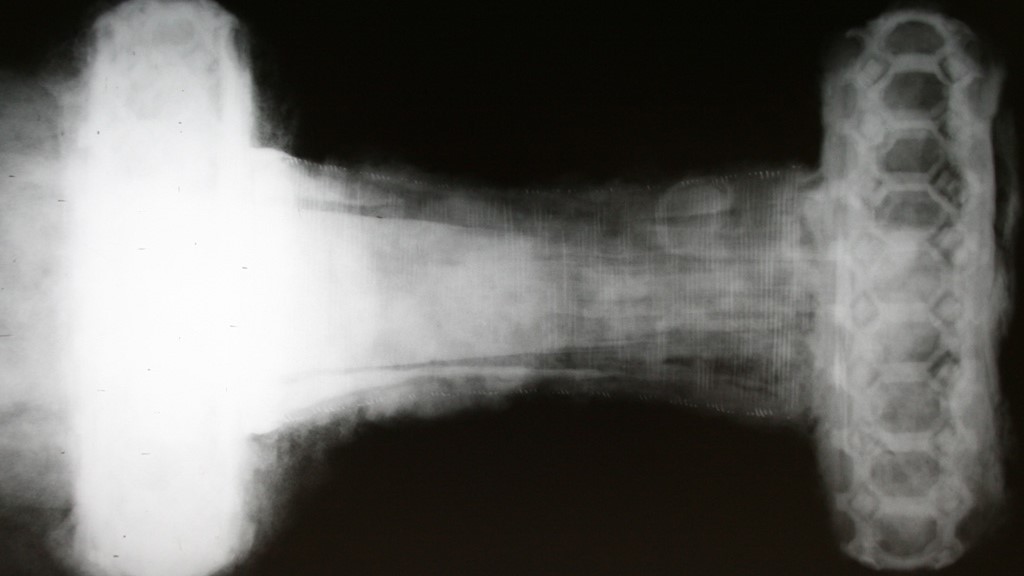X-ray analysis reveals 'highly decorated' Viking sword caked in dirt and rust
X-ray scans reveal what the sword would have looked like when it was made.

Archaeologists in Scotland have revealed the ornate hilt of a Viking sword after scanning it with X-rays. The sword is highly corroded and covered in dirt, but the new images show the weapon in a new light and reveal its striking design.
The sword is part of a hoard of Viking treasures unearthed in 2015 at a burial site on Papa Westray, one of the Orkney Islands located north of mainland Scotland. Archaeologists found the sword laid atop human remains. The burial also contained a buckle, arrows and a shield boss — the metal, central part of a shield. The site likely dates back to the first-generation Norwegian settlers, who came to the Orkney Islands during the 10th century, according to Historic Environment Scotland.
The sword was in very poor condition, and archaeologists were scared that removing the rust and dirt would irreparably damage the sword.
Related: Fierce fighters: 7 secrets of Viking seamen
"The iron in the sword has heavily corroded," researchers from AOC Archaeology, who are in charge of post-excavation work on the burial site items, wrote in a statement. "To preserve as much evidence as possible, we lifted the whole sword and its surrounding soil in a block to be transported to the lab and forensically excavated there."
The only way the researchers could see what the sword originally looked like was to analyze it using X-rays. The team released the first X-ray image of the sword on Dec. 7.

"Although it's currently only visible via X-ray, the guards [at each end of the hilt] appear highly decorated," the researchers wrote in the statement. "A series of elongated octagons and possibly raised lozenges [diamond shapes] have been used to create a honey-comb-like pattern, most likely using contrasting metals."
Sign up for the Live Science daily newsletter now
Get the world’s most fascinating discoveries delivered straight to your inbox.
This type of sword, called a Pedersen Type D, is the "heaviest from the Viking Age" and required a "substantial hilt to stabilize them," the researchers wrote. "We know of at least 30 of these blades throughout the Viking world," they added. "Approximately half have been found in Norway, with others discovered as far west as Dublin, and as far east as Slovakia, Poland and Russia."
Researchers also found partial remains of a wooden scabbard mineralized onto the sword's blade, suggesting the sword was sheathed when it was buried. The hilt of the sword also appears to be covered in mineralized organics, which could be the remains of a protective cover sewn directly onto the sword's handle. If confirmed by further tests, this could change what historians know about Viking weapons, the researchers wrote.
The sword was also found in a very unusual position. "It was laid over the top of the body with the hilt at the hip and the blade tip over the face, as opposed to the more common placement of the sword positioned alongside the body blade downwards," the researchers wrote.
The team plans to do further study on the sword. "It's so fragile we don't even know what the underside looks like yet, so our understanding is sure to change in the coming months," the researchers said. Hopefully, the blade "will have many stories to tell," they added.
Originally published on Live Science.

Harry is a U.K.-based senior staff writer at Live Science. He studied marine biology at the University of Exeter before training to become a journalist. He covers a wide range of topics including space exploration, planetary science, space weather, climate change, animal behavior and paleontology. His recent work on the solar maximum won "best space submission" at the 2024 Aerospace Media Awards and was shortlisted in the "top scoop" category at the NCTJ Awards for Excellence in 2023. He also writes Live Science's weekly Earth from space series.









